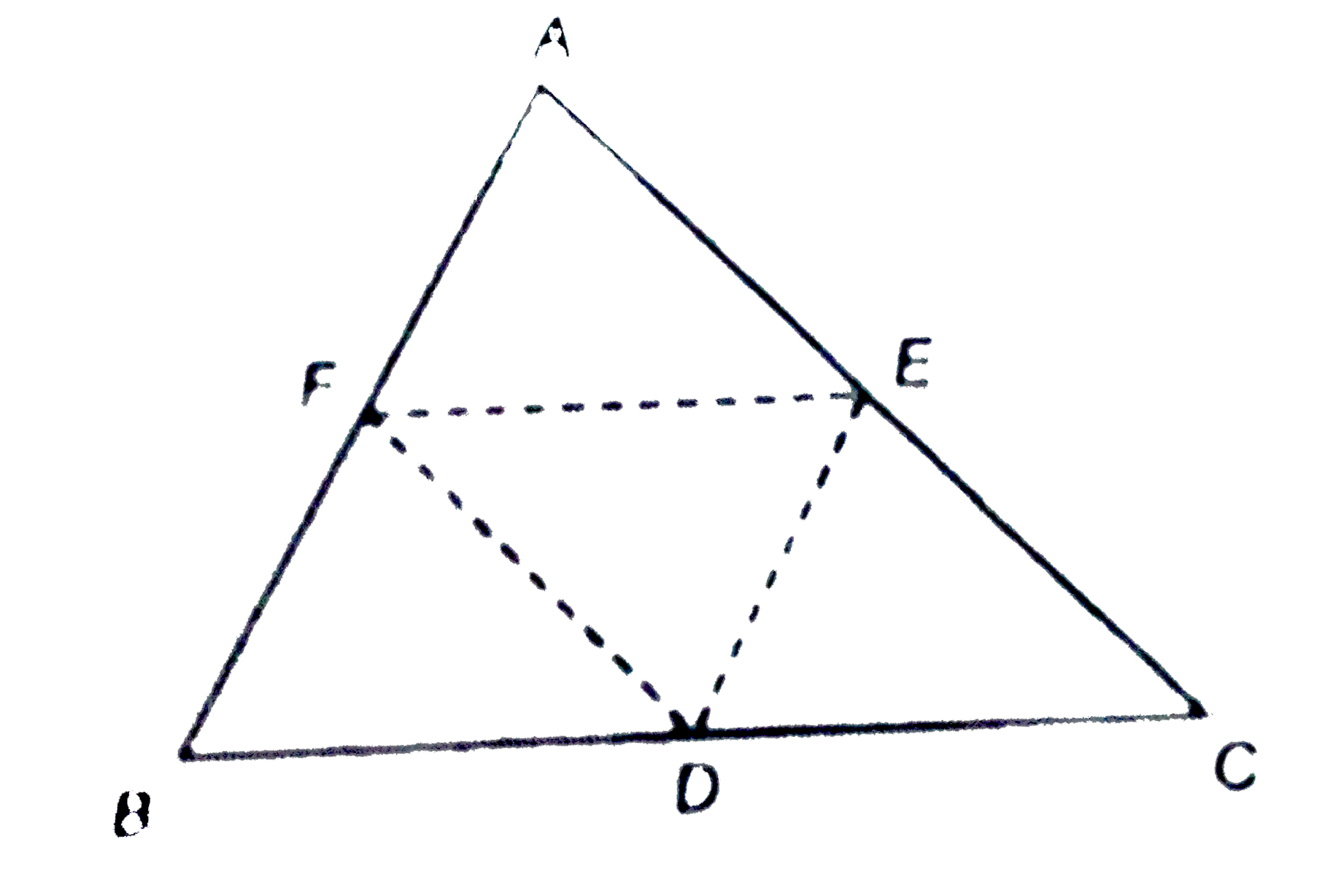If the mid-points P, Q and R of the sides of the are respectively, then is
right angled
acute angled
obtuse angled
isosceles
The correct Answer is:A,D
To determine the type of triangle ΔABC given the midpoints P(3,3), Q(3,4), and R(2,4), we will follow these steps:
Step 1: Identify the midpoints and their coordinates
The midpoints of the sides of triangle ABC are given as:
- P(3,3)
- Q(3,4)
- R(2,4)
Step 2: Calculate the slopes of the sides of triangle PQR
To find the slopes of the sides PQ, PR, and QR, we will use the slope formula:
slope=y2−y1x2−x1
Slope of PQ
Using points P(3,3) and Q(3,4):
slope of PQ=4−33−3=10→undefined (vertical line)
This means PQ is parallel to the y-axis.
Slope of PR
Using points P(3,3) and R(2,4):
slope of PR=4−32−3=1−1=−1
Slope of QR
Using points Q(3,4) and R(2,4):
slope of QR=4−42−3=0−1=0
This means QR is parallel to the x-axis.
Step 3: Analyze the triangle PQR
From the slopes calculated:
- PQ is vertical.
- QR is horizontal.
Since one side is vertical and another is horizontal, triangle PQR is a right triangle.
Step 4: Determine the lengths of the sides of triangle PQR
Now, we will calculate the lengths of the sides to check if triangle PQR is isosceles.
Length of PQ
PQ=√(3−3)2+(4−3)2=√0+1=1
Length of QR
QR=√(3−2)2+(4−4)2=√1+0=1
Length of PR
PR=√(3−2)2+(4−3)2=√1+1=√2
Step 5: Conclusion about triangle ABC
Since PQ=QR=1 and PR=√2, two sides of triangle PQR are equal, confirming that it is an isosceles right triangle.
Since PQR is a right triangle and isosceles, triangle ABC must also be a right triangle and isosceles.
Final Answer:
Triangle ABC is a right-angled isosceles triangle.
---
The midpoints of the sides of triangle ABC are given as:
- P(3,3)
- Q(3,4)
- R(2,4)
To find the slopes of the sides PQ, PR, and QR, we will use the slope formula:
slope=y2−y1x2−x1
Using points P(3,3) and Q(3,4):
slope of PQ=4−33−3=10→undefined (vertical line)
This means PQ is parallel to the y-axis.
Using points P(3,3) and R(2,4):
slope of PR=4−32−3=1−1=−1
Using points Q(3,4) and R(2,4):
slope of QR=4−42−3=0−1=0
This means QR is parallel to the x-axis.
From the slopes calculated:
- PQ is vertical.
- QR is horizontal.
Now, we will calculate the lengths of the sides to check if triangle PQR is isosceles.
PQ=√(3−3)2+(4−3)2=√0+1=1
QR=√(3−2)2+(4−4)2=√1+0=1
PR=√(3−2)2+(4−3)2=√1+1=√2
Since PQ=QR=1 and PR=√2, two sides of triangle PQR are equal, confirming that it is an isosceles right triangle.
Triangle ABC is a right-angled isosceles triangle.
Similar Questions
The coordinates of the mid points of the sides "BC", "CA" and "AB" of a △ ABC are (3,3), (3, 4) and (2,4) respectively. Then the triangle "ABC" is
View SolutionThe mid-points of the sides of a triangle are (1, 5, -1),(0,4,-2) and (2, 3, 4). Find its vertices.
View SolutionIf mid-points of the sides of a triangle are (1, 2, -3), (3, 0, 1) and (-1, 1, -4). Find its vertices.
View SolutionThree vertices of a triangle are A(1,2),B(−3,6)andC(5,4). If D, E and F are the mid-points of the sides opposite to the vertices A, B and C, respectively, show that the area of triangle ABC is four times the area of triangle DEF.
View SolutionIf the coordinates of the mid-points of the sides of a triangle are (1, 1), (2, −3) and (3, 4) , find the vertices of the triangle.
View SolutionIn a ΔABC the equation of the side BC is 2x−y=3 and its circumcentre and orthocentre are (2,4)and(1,2) respectively .
Circumradius of ΔABC is
View SolutionIn the adjoining figure D, E and F are the mid-points of the sides BC, CA and AB respectively of ΔABC. Prove that:
(i) □BDEF is a parallelogram
(ii) area of ΔDEF=14× area of ΔABC
(iii) □BDEF=12× area of ΔABC

View SolutionIf the coordinates of the mid-points of the sides of a triangle be (3, −2), (−3, 1) and (4, −3) , then find the coordinates of its vertices.
View SolutionThe mid-points of the sides of a triangle ABC are given by A(0, 0, 0), B(2, -1, 3) and
C(4, 5, 8) Find the coordinates of A, B and C.
View SolutionIf the coordinates of the mid-points of the sides of a triangle are (3,4),(4,6)and(5,7), find its vertices.
View Solution
